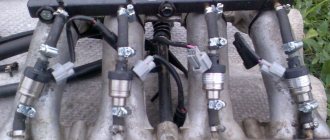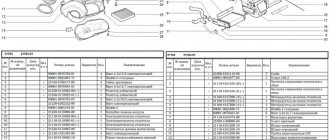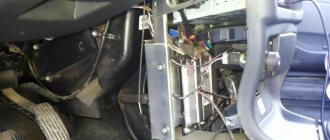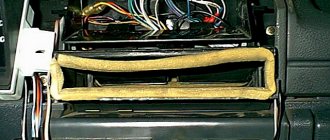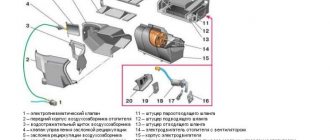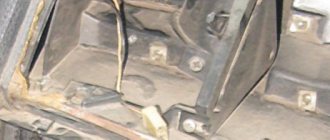The stove on the VAZ-2112 has its own operating characteristics. The system is assembled from the factory in such a way that its operation is not always stable. As the owner of the twelfth model, you most likely have already formed an opinion about the heating system of your car, and you need to find out information about diagnosing malfunctions of the stove if it is not working correctly.
In this article we will tell you about the main design flaws, and as a result you will know how to make the heating system work.
Finalization
The main reason for the “wrong” behavior of the stove is the poor placement of the diaphragms, which either do not come off completely or do not close completely. Moreover, the problem is solved in practice by simply altering the lever. To do this you will need a plastic card. You can use an unnecessary discount card or an expired bank card.
This is done as follows
- Remove the decorative plastic that covers the heater from below;
- Remove the damper position regulator. The lower part is removed from it; it is responsible for the operation of the front damper. This should be done carefully, the plastic here is fragile, one awkward movement and you will have to restore the part using a soldering iron;
- We fix the lower flap in the upper position. To do this, we cut out a suitable bracket from simple sheet metal and secure it with self-tapping screws. After this, you will completely lose the frontal position;
- Next, we take a plastic card and cut out a new path in it for the movement of the damper drive. Glue the resulting blank onto the damper. For greater accuracy, we file all the side parts;
- After that, all that remains is to put everything back in place.
Read more: Elm327 mini how to connect As a result, we get the ability to distribute air to the windshield or to the feet of your choice. You can also relatively smoothly regulate the amount of air supplied in different directions.
After such a modification, you may encounter a decrease in air flow. This is due to air redistribution. The result is that in the middle position the cabin is still quite cool. To eliminate this drawback, you will need an unnecessary plastic canister. We cut off the neck from it and attach it to the deflector. The result is a fairly powerful and targeted flow.
Temperature does not change
In this case, you fail to adjust the internal climate, and the result is sometimes both unbearable heat and cold. The reason for this may be the following:
- The control unit does not receive information from the temperature sensor. This measuring device is installed in the ceiling next to the lampshade. To check its functionality, turn the adjustment knob to its extreme position (several times). If there is no reaction or it appears in the extreme position, it is necessary to change the sensor.
- Damper failure. It is quite possible that the damper is simply jammed and is now unable to turn. The reason for this is oxidation of the mechanism fastenings. It is possible to get to the damper only from the engine compartment. Initially, you need to remove the deflectors, bend the antennae, and only then try to move the element.
The flap may be deformed. There is a plastic part on the VAZ-2112. Therefore, if you change an element, it is better to install an aluminum one. Such a damper will last longer and will retain heat better.
In addition, the damper may not work correctly due to failure of the drive motor. To check, you need to remove the insulation and frill. This engine cannot be repaired, it can only be replaced with a new one.
Some drivers ignore the need to replace the motor and leave the throttle open. In this case, it will not be possible to regulate the temperature in the cabin, and hot air will constantly flow.
The main reasons for a non-working stove
If the VAZ-2112 stove does not heat well, then one of the following problems may be occurring:
- Impossibility of temperature control.
- When there is a cold air flow under the hood, uncharacteristic clicking sounds are heard.
- The radiator is leaking.
- Lack of functioning of the temperature sensor, which can be found on the ceiling of the cabin.
- Damage to the ACS control unit.
These reasons are the most common. You can eliminate each of them yourself, and we will tell you how.
Inability to regulate temperature
If the VAZ-2112 stove does not heat, then it is worth checking whether it is possible to regulate the temperature regime. This problem may occur due to malfunctions in the control unit or due to a malfunctioning damper. First of all, it is worth checking the serviceability of the temperature sensor, which is located on the ceiling of the cabin near the ceiling lamp. We turn the temperature control lever starting from the cold position and ending with the hot position. Although temperature changes will still be felt. If the supply of hot air begins only when the sensor is installed in the hot extreme position, then we can speak of its failure and prepare to replace it with a new element.
First of all, check the temperature control lever
Damper problems
If the stove is not blowing well, then it is worth checking the operation of the damper. The fasteners on it may oxidize and in this case the damper will not turn. You can only get to the damper through the hood, after first removing the deflectors and bending the antennae. After such actions, you can try to move the damper from the inside. If everything is fine with the damper and there are no traces of oxidation on the fastenings, then it will move easily.
The damper drive has a micromotor, which is located near the windshield under the hood. This element can also cause the stove to not heat. To get to the micromorch, it is necessary to dismantle the frill and insulation. When the warm air supply is turned on, the lever should move, this indicates the serviceability of the motor.
The design of the motor contains gears that tend to wear out and, as a result, slip. In this case, you should seriously think about replacing the motor. Although among car owners there are craftsmen who drive without a motor and close the throttle with their hands. With such repairs, the stove will constantly blow hot air, which is not at all good.
If there is poor airflow, you should check the operation of the damper.
Radiator leak
When the heater is not blowing, it is worth checking the radiator for leaks. Adding fluid to the radiator only saves the situation for a while, but then the problem with the heater arises again. A leaking radiator is one of the complex problems that relate to the heating system of the VAZ-2112. The main snag is the need to dismantle a large number of parts, including the stove itself.
If the condition of the radiator is unsatisfactory, the best solution is to replace it. Of course, small cracks can be soldered and still enjoy a comfortable ride for some time. If large leaks are detected, you should still think about replacing the radiator, otherwise you will have to assemble/disassemble the car quite often.
Other ways to solve the problem
It also happens that the stove blows hot air and everything seems to be functioning properly, but still your feet get cold and the windows sweat. Replacing the corrugation will not improve the situation much. But if you insulate the interior and eliminate existing cracks, then the flow of warm air will purposefully move towards its goal and will not be wasted fighting cold air. You will also need to stock up on anti-creaking and mounting foam to insulate and seal the panel.
If the heater blows cold air despite all your efforts, then it may have already served its useful life and it’s time to replace it with a new one. VAZ-2112 owners are offered two replacement options to choose from: model 2112-01, the design of which does not provide a cleaning filter, and model 2112-02 with a filter with a working reserve of 15 thousand km.
Alternatively, you can install a preheater in your car. This device will reduce the time it takes to warm up the engine and interior.
Heating system and its composition
The heater is also located in the compartment where the engine is located. It is usually attached to the front shield. The inlet through which air enters for heating is fixed by a filter. It cleans the incoming air and enters the cabin already filtered.
The Priora stove has the following components:
- filter cover;
- the filter itself;
- frame;
- micromotor gearbox;
- radiator;
- resistor;
- fan.
Principle of operation
This device, which is responsible for heating the interior of the Priora, has important mechanisms. Without them the process would not have taken place. The important nodes are:
- The functioning of the next component is called the Priora heater control unit - there are special knobs; when rotated, they are responsible for various parameters of the entire system. The correct work process depends on their working condition.
- Temperature sensor in the cabin - with its help you can maintain a stable temperature in the cabin throughout the trip.
- Additional resistor - it is located in the fan housing along with other elements.
- Correctly connecting the radiator through special hoses to the cooling system helps avoid overheating. Due to the fact that part of the cold air is supplied for heating, and the second for cooling, you can use the stove for a long time without fear.
- The heater damper micromotor is responsible for control control. With its help, you can direct the flow not only inside the cabin, but also in different directions, in particular: to the front window and the driver's and front passenger's doors. This not only warms up the interior, but also melts glass that is frozen or fogged up due to the large temperature contrast.
The stove in the Priora has such features, but not all operating aspects were familiarized with.
Features of air distribution
You can be convinced from personal experience that the warm flow does not flow to a certain point, it spreads evenly throughout the entire car. This is a feature of the priors, for which elements such as:
- air ducts on the sides;
- glass blowing;
- air distribution housing;
- Priora's heater damper and its gearmotor;
- air duct at foot level.
The air distribution housing and air ducts are held to the panel by fastening to the rear of the panel. The air distributor inside has special dampers. Their adjustment allows you to change the direction of warm wind flows. When the car is in motion, air enters it with a certain pressure. The faster the vehicle moves, the stronger the pressure. To ensure that the interior heating process occurs evenly regardless of the speed, manufacturers used a fan. It works at all speeds - the stove control unit is responsible for this.
Interior ventilation
Interior ventilation is an important component of a comfortable trip. The vehicle must not be hermetically sealed. Therefore, there are not only valves that allow warm air to enter, but also those thanks to which it leaves. They are located in the back of the car. When putting things in the trunk, you need to make sure that the openings are not blocked. Otherwise, the excess will not be able to exit the cabin. Excess warm air can disturb those sitting inside, moreover, the lack of freshness in the car can make you dizzy or there is a possibility that a person will lose consciousness
That’s why it’s so important to check the performance of the ventilation system.
Other Possible Causes
These include the following options:
- Liquid entering the car ignition relay. One effective piece of advice will help you find out that the fan is failing precisely because the relay is flooded. If a previously “stalled” fan began to function again as soon as the car engine had been running for 20-25 minutes, that is, after the vehicle had warmed up, then we can say with confidence that the cause of the malfunction is precisely the flooding. To get rid of this problem, it is necessary to replace the ignition system relay that has become unusable.
- If during testing it turns out that the fan operates only at one speed, namely the third, then you will need to check the serviceability of the additional resistor. This element supplies voltage directly to the fan only in the 3rd speed mode, so if the device cannot be started in the 1st and 2nd speed modes, this part will need to be replaced.
- The car heater fan may stop working due to a breakdown of the switch, which is responsible for the functioning of the entire heating system. To verify this, you need to remove the central part of the console, start the engine and, using a light bulb whose power does not exceed 12 V, equipped with connecting wires and a wire to “-”, close it to the car body. And with the second wire, check the operation of all three contacts that belong to the additional resistor. If during the test the light stays on, then the switch can be considered serviceable; otherwise, you will need to replace the fuse and check the integrity of the electrical circuit.
If all of the above failure options have been analyzed, but the VAZ-2110 stove fan still does not work, you need to check several additional reasons:
- serviceability of the electric motor of the device;
- check the motor contacts;
- make sure that the brushes are not stuck or stuck on the main body.
Modernization of the VAZ-2110 stove
Replacing the radiator of a heating device in a Lada Priora car
Almost every motorist who owns a domestic vehicle discovers a malfunction of the car’s heating unit in the winter. After all, only with the onset of severe cold does a person begin to think about how to avoid freezing while driving a car. Naturally, everyone uses a stove for this. However, what should those for whom this very device has ceased to function properly do? After all, only the heater can ensure that the cabin maintains a normal temperature, allowing for comfortable movement. In this article we will look at only one reason why the heating device stops working, we will learn about the principles of repairing and replacing the heater radiator installed in a Lada Priora car.
If the motorist is sure that it is necessary to replace the heater core, it may take a lot of time to eliminate the faulty object, since most likely, in the process it will be necessary to replace not just a blown fuse, but to carry out more serious repair work. True, you should not immediately despair because of your ignorance; the material contains detailed instructions to help everyone understand how to replace the stove radiator in a Priora with and without air conditioning.
How to avoid the problem
If the airflow in your car works well, and you want it to continue to work that way, then you should follow a few simple rules:
- Use high-quality and suitable coolant.
- Monitor the coolant level and add it immediately if necessary.
- Periodically clean and vent the radiator to avoid severe clogging.
- Monitor the condition of the stove fan and if it loses power, replace it (preferably with a fan from a foreign car, as discussed above).
Following this will help avoid most of the troubles that may arise with the interior airflow system.
Poor damper operation
The damper has two extreme positions: “the radiator core is closed” and “the cold air supply hole is closed.” It’s easy to guess that in the first case, unheated air will enter the cabin, and in the second, heated air. The damper is rotated using a special cable, but over time it stretches. After some time, it will increase so much that it will not be able to fully do its job. In this case, the valve will not be completely closed. If it remains in the middle position, then both holes will be open at once, and the inside of your car will be cold. There is only one solution to the problem - adjusting the length of the cable. And this needs to be done regularly (at certain intervals).
The stove does not blow at the feet of the VAZ-2112 for drivers and rear passengers: reasons, repairs
In this article we will tell you about the main design flaws, and as a result you will know how to make the heating system work.
How the VAZ-2112 stove works
The functions of the stove include not only heating the air flow, but also ventilating the interior. When the fans are turned off, air naturally enters the car through air ducts located in the cabin.
Ventilating and heating deflectors are equipped with special valves that are required to ensure that air does not escape back out of the cabin. Accordingly, fresh air must flow freely through the air channels.
Unlike classic VAZ models, the 2112 does not have a tap in the system. The damper is responsible for regulating the air temperature, which also limits the volume of incoming air.
Coolant is always present in the stove. This design feature forces car owners to think about installing an additional tap to prevent the stove from heating up in the summer.
According to the data sheet, the adjustment accuracy is approximately ± 2 degrees. As practice shows, this is not true. Accordingly, owners install taps so as not to get burned in the summer. The main disadvantage of the faucet is its tendency to oxidize.
In winter, heated air flows primarily onto the windshield. This is where the main flow goes. The rest goes under the feet of the driver and the passenger sitting in front.
In the VAZ-2112, rear passengers are not heated. There is only a floor-level air duct that supplies air to the rear of the cabin. The main reason that the stove does not blow into your feet is the lack of volume and heating power of the air. Structurally, the heating system is not designed for such productivity.
Troubleshooting the stove on the VAZ-2112
- Check the temperature sensor. It should change resistance based on the temperature in the cabin. Accordingly, at 22 degrees Celsius its resistance should be 20 Ohms. At 16 – 25 Ohms. If the indicators do not match, it is recommended to replace the sensor.
- If the stove does not work in automatic mode, the controller may be the reason. It is also tested with a multimeter. After turning on the ignition and rotating the adjustment knob, the voltage at the long terminal is measured 10 seconds after switching the mode. If this does not happen, you need to replace the controller.
- When the heating system does not respond to changes in the position of the regulator, the reason may lie in the relay block. It is located under the hood on the right. The heater relay is indicated by the corresponding picture. If the load was too high, the contacts may simply burn out. To do this, remove the controller and visually inspect the condition of the contacts.
- The next step is to check the resistor that is connected to the heater motor. You can access it from under the hood.
- A low level of coolant in the system also affects the stable operation of the heater. In this case, it is possible that air will enter the heater radiator and form a plug. Thus, the radiator simply cannot heat up.
- If everything is fine with the antifreeze, but the radiator does not warm up, check the thermostat. The element may not open completely and coolant cannot enter the radiator.
The stove does not blow at your feet, what is the reason?
- The electromechanical part of the stove is faulty.
- Air leakage from air ducts in damaged ducts.
- The intake air duct is dirty.
- Unstable operation of the control valve.
If everything is fine with the electrical and mechanical parts of the system, then you need to pay attention to the correct distribution of air entering the cabin. Car owners modify the deflectors, channels through which air flows, and sealing covers. All connections are sealed and the air ducts are extended to provide air flow to the rear row of the car.
As practice shows, poor air supply to the lower part of the cabin is a consequence of incorrect operation of the damper. It just so happens that it was assembled poorly from the factory and directs half of the air to the front panel. To correct this situation, you need to seal the damper and replace the seal so that the regulator fits tightly to the body.
To summarize the article, we note that the entire system on the VAZ-2112 is developed quite well, but requires high-quality assembly, which is not available from the factory. If you bring the system to perfection, the stove will work perfectly even in severe frosts. Now you know what stove malfunctions can occur and how to fix them.
Elements of the ventilation and heating system
The stove body (in Fig. No. 5) is located in the car interior under the instrument panel frame. Inside the case there are:
- heater radiator;
- electric fan;
- fan speed controller (RFV) or additional resistor;
- air flow distribution damper;
- gear motor that regulates the dampers;
- air filter.
The heater radiator releases heat to heat the interior. Located inside the case on the left side. To replace it, you will have to remove the upper frame (lining) of the panel (dashboard).
An electric fan forces air into the car interior through air ducts. It is located on the other (right) side of the body. Access to it opens after removing the glove compartment.
The additional resistor is designed to regulate the rotation speed of the fan motor. It is installed on the heater housing on the driver's side.
The cabin filter cleans the air entering the cabin. Located in the heater block on the passenger side. It is replaced from inside the car (and not from the engine compartment, as on Grant, Kalina or Priora). In addition, the filter element resource is 30,000 km, and not the usual 15 thousand km.
The job of the gear motor is to regulate the position of the damper, which distributes air throughout the cabin. How this happens is shown in the video:
Air temperature sensors in the cabin and outside transmit readings to the engine control unit (ECU).
The control unit for the stove (heater) and air conditioner (SAUKU) is designed to regulate the air temperature in the cabin, change the speed and direction of air flows, and control the heaters. Depending on the configuration, the SAUKU may differ slightly. There are three types in total:
- SAUKU without air conditioning;
- SAUKU with air conditioning;
- SAUKU with climate control.
Causes of poor heating
The reasons for insufficient heating vary. The most common of them is an insufficient amount of antifreeze in the engine cooling system. To determine the amount of coolant, you need to check the expansion tank and add antifreeze to the level if necessary. The next significant reason may be hidden in the heater core. Often a crack or small hole appears in the radiator, which affects the quality of its operation.
An air lock is another problem that prevents the radiator from fully performing its functions. You can try to eliminate it. To do this, you need to drive your front wheels onto a hill and stand for several minutes with the engine running at medium speed. In some cases, simply replacing the cabin filter is enough. The reasons, as you can see, can be different; some will take a few minutes to eliminate, while others sometimes take half a day. But let's look at what needs to be done if the stove does not heat well.
The simplest solution
If the heater blows cold, the simplest thing you can do is tighten the cable that controls the heater damper. To do this, wrap it a couple of times around the damper control lever. It is located on the heater housing near the gas pedal.
Each joint of the air duct and the edge of the heater damper are covered with foam rubber, which is quite problematic for the control lever to compress completely. Therefore, during compression, a small gap remains and the damper, which directs air flows from the street directly or through the stove radiator, cannot close completely. It closes in its upper position, while air flows into the front nozzles through the heater radiator, and into the upper and side nozzles from the street through the remaining gap. When the heater fan is running, and the car is still moving, a small gap is enough to keep the cabin cold.
Modification of the air ducts of the VAZ 2110 – 2112 stove
The VAZ 2110 - 2112 has one bad feature: the heater does not work well, or rather, the flow of warm air weakly blows into the driver’s feet and onto the front side windows. For this reason, every now and then your feet freeze and the windows fog up. But as they say, there is always a way out of every situation. The solution would be to remake the stove, or, more precisely, its air duct. So, let's begin. Before starting work, you need to make sure that the stove is working well, otherwise you will have to repair it. If it works properly, then we begin work. First we will need to remove the torpedo and disassemble it into parts. All elements of the stove panel are bolted together.
There are 2 options for solving the problem with poor blowing of the side windows:
- The first option is to lay a corrugated hose for blowing glass.
- The second option is to glue all the existing cracks on the dashboard.
For better blowing of the side windows, I chose option 2. The prerequisite for this choice was that corrugation is good only for heating the legs. In general, the second option is better than the first, so let’s get to work on gluing all the seams and cracks of the air ducts. Using silicone we glue the gaps between the lower and upper parts of the torpedo, as well as the holes for fastenings.
Next we move on to modifying the furnace dampers, which direct air to different zones. From the factory, the damper does not fit well to the body, so some of the warm air disappears, getting into the cracks between the damper and the body. The air begins to flow into nowhere, or more precisely, it circulates under the panel and does not provide heat.
Let's start dismantling the damper, remove the damper and see how Auto VAZ is still worried about us, the factory seal cannot be called a seal, it does not seal anything, but only slightly covers the cracks. Once the seal is removed, you will see gaps.
Using insulation, I glued the entire valve and removed the cracks. This procedure will have a good effect on the flow coming out of the damper; the air will not be lost in the gap before exiting, but will flow into the cabin in full. If you knead the lips, you can use Bitoplast 10 on the body. We work carefully with Bitoplast 10, in some places it will be necessary to glue it in 2 or even three layers, in a word, we make it last forever.
A larger percentage of the incoming air disappears in the area where the air begins to travel to the driver's window. This gap is very large, so I decided to foam it with polyurethane foam. Perhaps someone will wonder if the foam squeaks when driving, I will answer - no, it has been tested by time.
Next, let's move on to improving the air ducts in the area of the driver's feet, front and rear passengers. The module for distributing warm flow to the feet, as you already understood, is also full of cracks.
Because of these cracks, the wind blows poorly at your feet, because half the force of the flow goes nowhere. I thought a little and a great idea came to my mind. I decided to use corrugated pipe. This pipe is doubly good, since it delivers warm air in the initial volume, but also does not take up much space during installation.
The small size of the corrugation will free up space in a pile of wires, making it easier to access the wires. I did everything this way: I removed the standard air distributor, pushed three corrugations into the remaining hole and filled everything with foam.
The central corrugation has a smooth surface inside the hose, because if you install a hose with a ribbed surface inside, the stove will whistle when turned on. The diameter of the corrugation should be 40 millimeters - no less, no more. So what do we get? One corrugation goes to the driver’s feet, the second to the front passenger’s feet, and the 3rd goes back at the rear passengers’ feet. Then we put the entire structure in place and enjoy the warmth. And so, without investing a lot of money, we modernized the stove and it warms the interior better.
Diagnostics
The most important thing in repair is a competent diagnosis, identifying the primary cause of the malfunction. We'll start with the engine compartment. Check the coolant level. We start the engine and warm it up to operating temperature. If the engine gains temperature and the pipe before the thermostat is warm and after it is cold, this means that the thermostat is working and the problem is not in the engine cooling system, but in the cabin heater.
Reason #1
The heater damper control cable has become loose or has come off.
Solution
- Disassemble the driver's side panel.
- There is a damper control lever on top. A cable from the control lever on the center console (cold - hot) comes to it.
- We visually inspect the cable itself and the damper control lever.
- If everything is intact, then it just stretched.
- Unscrew the cable bracket and remove it from the lever.
- We take the eye of the cable with pliers and turn it clockwise so that the cable becomes shorter.
- We assemble everything in reverse order.
- Without assembling the side panel, let's check it.
In most cases, the cause of the malfunction is the cable, but if the problem is not solved and the stove continues to blow cold air into your feet, then we’ll look into it further.
Reason #2
The air ducts and dampers are poorly assembled and there are gaps between the joints. The air ducts themselves can be severely broken at bends and not allow air to pass through, then warm air simply blows only from the central deflectors and heats the panel itself inside.
Solution
- We inspect the air ducts. If there are cracks or kinks, it is better to replace the air duct with a new one.
- We seal the flaps with self-adhesive foam rubber.
Such simple tips will help owners make their trips comfortable in cold weather, and especially in winter, when a foggy windshield can make further movement impossible, or can lead to an accident. Well, if these tips didn’t help you, then it’s much more serious and you most likely won’t be able to solve this problem yourself. And in this case, you need to contact a service station. But in most cases, the problem can be solved using the above methods.
Weak warm air supply
The air flow is warm enough, but the pressure is insufficient. In such a situation, the following malfunctions are possible:
- The cabin filter is dirty. In this case, you need to clean it from dust with a vacuum cleaner. If this cannot be done, then it is better to replace it.
- The stove radiator is clogged. In addition to dust, both insects and leaves create plugs. Small particles can be blown out using compressed air. To remove large dirt, you need to remove the grill and wash it.
Insufficient air pressure may be due to a leaking radiator
This problem is determined very simply - if you constantly add antifreeze or antifreeze, then pay attention to the condition of this unit in the car. To eliminate this malfunction, you will need to gain access to the radiator and remove it along with the heater
The practice of soldering the heatsink is unreliable. It is better to install a new part so as not to disassemble half of the front end later.
Lada Priora with air conditioning
The structural features and functionality of heating a car with an air conditioner have some differences. Thanks to this element, a hot, cold climate is created. On this vehicle model you can see two types of air conditioners: Korean-made and from Taiwan. The Panasonic brand air conditioner (Taiwan) has a start button, the second one does not.
Depending on which company installed the cooling equipment, there are some differences in the process itself. Among the main differences it is worth noting:
- The difference is in the compressors - Panasonic is bladed or rotary with a volume of 120 cm3, the Korean one has a volume of 160 cm3.
- Mounting point – the air conditioner, made in Taiwan, is mounted on the body, the second – to the radiator. It also has a larger refill capacity.
- The air distributor in Panasonic is located in the cabin, the Korean one is located where the gearmotor is.
If the model installed initially is not satisfactory, a replacement is made with another option.
So that the stove always warms
Follow simple rules for proper operation of the stove.
If you pay attention to the heating system and do not start this important element of the car, you can protect yourself from unpleasant surprises, lengthy repairs and unnecessary expenses. Follow simple rules and the stove will always work properly
- Regular cleaning of the radiator is the main condition for the normal operation of the heating system.
- It is advisable to fill the radiator with high-quality antifreeze from reliable manufacturers. Using a fluid of questionable quality will lead to rapid build-up and the need for frequent cleaning of the system.
- Antifreeze should be replaced at least once a year.
- If the thermostat is faulty, then it must be replaced with a new one, the sooner the better. The thermostat often gets stuck in the open position, which leads to insufficient heating of the interior and prolonged warming of the car itself. If the thermostat breaks while it is closed, the car may overheat, which will entail serious consequences and costly repairs.
- The stove does not heat well when air gets into the heating system. This is not the worst problem, which can be easily eliminated by manually pouring antifreeze or idling the car for a short time.
- It is necessary to periodically check the damper control levers to ensure they are working properly. If the cable has come off and the valve is faulty, the air flow will not be sufficiently heated.
- The stove fan design contains bearings that sometimes need to be lubricated.
- Using cabin filters and regularly cleaning or replacing them. Air passes through a clogged filter with difficulty, therefore the stove will not work at full capacity.
Now for each of you the question of why the stove on the VAZ-212 does not work will not seem so difficult. You can find the cause and eliminate it without specialists; you only need desire and at least minimal car maintenance skills.
Malfunctions in the heating system
Now let's discuss why the VAZ 2110 stove may heat poorly.
There are several main reasons for this:
- firstly, the seal in the radiator of the device was broken, which led to a leak;
- secondly, there is no way to change the temperature regime of the heater;
- thirdly, elements of the system such as a gearmotor or damper have failed;
- fourthly, there were malfunctions in the operation of the automatic control system (the unit responsible for controlling the heating system);
- fifthly, the temperature sensor, which is mounted in the ceiling of the car, is faulty.
Winter has come, and many car owners are beginning to notice that their car's heater is not heating well.
This is the wrong approach. It is necessary to prepare the “sleigh” in the summer - isn’t that what folk wisdom says?
Therefore, it is advisable to carry out diagnostics while still warm and, if malfunctions appear, fix them immediately.
How to act if the VAZ 2110 stove does not heat well, read on.
VAZ 2110 stove device
The car heater must not only heat, but also ventilate. If you do not turn on the fan, the air enters the car naturally - through the ventilation slot under the windshield and passes through the channels in the cabin. The ventilation and heater deflectors are equipped with check valves so that heat does not escape from the machine, and fresh air can freely flow into the cabin.
Unlike Zhiguli cars of classical design, the “tens” system does not have a tap. The temperature in the cabin is adjusted using a damper that limits the flow of air. Antifreeze is constantly in the system, which forces many owners to make changes to the design early on and install an additional tap that would prevent the antifreeze from heating in the summer. The certified adjustment accuracy (±2°C) does not correspond to reality, which is why many people install taps so as not to get burned on the hot elements of the heating system in the summer. The downside of the tap is that it can oxidize.
In the cold season, the heat from the heating radiator flows mainly onto the windshield, and part of it flows under the feet of the driver and front passenger. The design of the car does not provide for heating the rear passengers. Only a deflector is installed at floor level, which in principle should supply heat to the rear of the cabin. The reason why in 2110 it is not supplied to the feet of the rear passengers is that there is not enough volume and temperature of warm air. The system is simply not designed for such productivity.
General information
Poor airflow is mainly caused by those modifications that have a high panel installed. Often faced with a situation where warm air does not reach their feet, owners begin to change the main elements of the heater one by one:
Having spent a lot of money on this, they do not achieve any noticeable improvement. Meanwhile, the reason here is very simple. Most often, this happens due to incomplete closure of the central sand damper.
The problem here is that the outlet for the foot airflow is located below the previously mentioned part and therefore, if its seal is broken, cold from outside enters there. At the same time, excessively hot air is blowing into the driver’s face, and his legs are cramping from the cold.
The VAZ-2109, which has a low panel, is practically free from such a drawback. The thing is that they were equipped with heaters of a slightly different system, more simple and reliable.
Broken gear motor or heater
In almost all cases, a non-working gear motor is easier to replace. In order to release this element, it is necessary to remove the windshield wiper, “jabot” and unscrew the screws. After this, you need to remove all the wires going to the gearmotor, and then remove it too. Next, change the non-working element and adjust the air supply.
The heater malfunctions very rarely, but it should also be checked. To determine its condition, you need to dismantle the main deflector and also straighten the fasteners. Large amounts of scale or mechanical damage will indicate a non-functional condition.
Principle of operation
The heater consists of:
Essentially, it is a heat exchanger connected to the cooling system of the power plant via a heater tap. If you open it, hot coolant enters the radiator. There it cools, giving off heat to the metal plates and returning to the circuit.
The main unit that supplies heat to the cabin is a fan. The air blown through the radiator is heated there and supplied to the nozzles, by closing and opening which the driver and his passengers regulate the temperature and direction of the flow.
